There are endless cliches out there about the importance of a first impression, but whatever truth they may hold in our everyday lives they go double for film. When there’s only a couple of hours to tell a story and capture its players, an audience’s first chance to meet a character is an asset no filmmaker worth their salt is going to waste. So with that in mind, CHUD is going to take a look through the many decades of cinema to extract the most special of those moments when you are first introduced to a character, be they small moments that speak volumes, or large moments that simply can’t be ignored.
Inevitably it will be the major characters and leads that are granted the grandest of entrances, but don’t be surprised to see a few supporting players and minor individuals get their due, when the impact of their appearance lingers longer than their screentime. Also know that these moments may be chosen for any number of reasons, and the list could never be exhaustive. But here you’ll find moments that make a big splash, say a lot with a little, or we think are just particularly cool.
We hope you enjoy, and can’t wait to hear from you about each and every entry. Don’t spend the effort guessing future choices or declaring what must be included– just enjoy the ride!
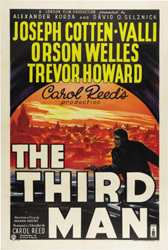
The Film… The Third Man (1949)
Director… Carol Reed
Entering From Stage Left… Orson Welles in the role of Harry Lime.
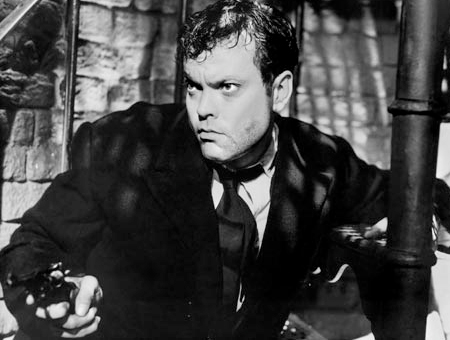
What Makes it Special… The Staging.
Well…sorta.
Actually, the first time we’re introduced to Harry Lime, Orson Welles isn’t anywhere to be seen – Harry Lime is a dead guy, a corpse. We (along with lead character Holly Martins) attend his funeral not 15 minutes into the film. And without a physical body to keep him grounded as a person, Harry Lime becomes less a character and more a…I don’t know – force of a nature. The longer Martins stays in Vienna and the deeper he digs into Harry’s death, the more people he meets who have been affected in one way or another by Lime. Profoundly affected. And he means something different to each of those people – Martins included. Lime takes on a sort of mythical identity and it’s an identity that’s fluid and changes depending on who you ask. And as we go through the movie and Martins keeps digging and digging, looking for the mysterious third man that was at the scene of the accident where Harry was killed, Inspector Calloway drops a bombshell – Harry was, in essense, a murderer. He proves his case to Martins who, completely disillusioned, gets shitfaced and goes to try and connect with Harry’s ex-lover as they both try to recover from having the rug pulled out from under them about someone they both held very, very dear.
That, in essence, is who Harry Lime is – he’s a cause and an effect. He’s the stone and the ripples. He’s everything because he’s nothing – he’s just an idea upon which the characters (and the audience) can project whatever it is that they need because he’s not there.
Until he is.
And this is where my namedropping the staging earlier comes into play. While Holly and Anna are talking, Anna’s cat hops out the window and saunters across the street where it starts nuzzling up to a pair of black dress shoes – the owner of said shoes obscured by shadow (and the framing of the shot). We cut back and forth between the inside and outside, everything’s all dutch angles and zither music, and when Holly finally leaves he immediately sees the obscured stranger. And it’s important to note that on our way to this point, Holly has run across more than one sort of unsavory person who wants him to leave the case be and he’s become unofficially suspected of murder when the porter at the hotel in which he’s staying turns up slain (the same porter who tipped Holly off that there was indeed a third man at the scene of the accident). Holly, knowing he’s being tailed, immediately starts shouting and causing a scene, which then prompts a lady in an upstairs apartment to turn on her light which immediately reveals who’s been standing in the shadows.
And it’s this guy…
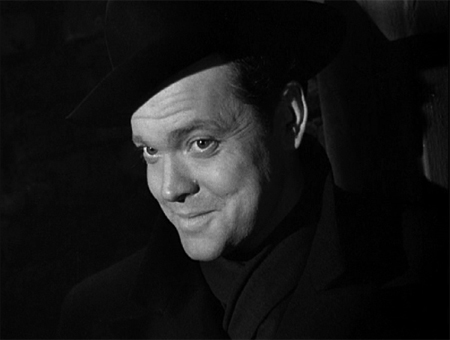
….making that face.
Why it Resonates… For a couple of reasons actually. On a more superficial level, it’s the fact that Harry doesn’t say a single word. He just appears – out of thin air, almost – smirks that little smirk, lifts his little eyebrow up and just as quickly – he disappears. The whole thing takes less than a minute and in just that tiny amount of time, everything is turned on its ear. It performs this nice little magic trick of almost essentially starting the film over without negating or expecting you to forget everything you’ve just seen.
But the reason it’s able to pull off that little magic trick is because of Orson Welles himself. Harry knows what he’s done and he knows that Holly knows and when that lady turns her light on it’s a simple little metaphor for Harry being revealed for who he truly is. It’s certainly the first time we’ve ever seen him, but – in a lot of ways – it’s also the first time that Holly’s ever seen him. Really, truly seen him. And with nothing more than that little smile, Welles is able to make Harry say “Yeah, you got me. It’s all true. And it’s kind of impressive, if I do say so myself.”
So, in other words, it resonates because our two leads have spent the entire film defending, eulogizing, idealizing and romanticizing this guy and when we finally meet him he turns out to be a DICK.
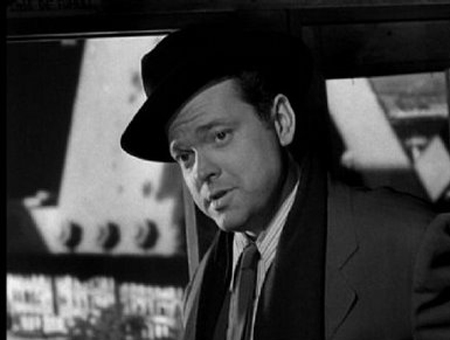
Other Grand Entrances… Entrances – not exactly. But there is a grand exit and it’s the second greatest shot in the film (the first having been covered above) and, possibly, the most powerful moment. After Martins kills Harry in the subway tunnel and subsequently attends his second funeral, Calloway is driving him out of town when they pass Anna walking down the road. Holly has Calloway pull over and drop him off and he stands there waiting as Anna walks up the road – hoping to be able to talk to her. Reed never cuts, never zooms, never moves the camera at all and we watch as Anna walks up to Holly…and right past him. Never looking in his direction, never saying a word. Holly lights a cigarette as she walks out of frame and we fade to black.
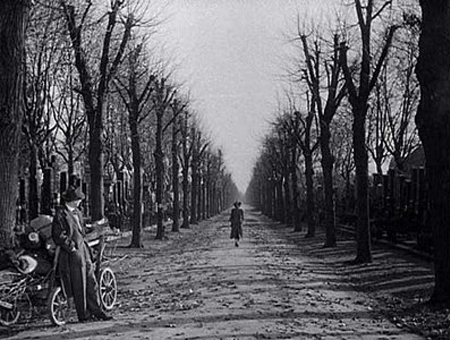
In a lesser movie or in the hands of a lesser filmmaker, Holly and Anna would have ended up together, bonding over their shared loss and finding comfort in each others’ arms. Instead, Anna’s character is given a healthy dose of tragic realism. She states earlier in the film, once she’s learned of who and what Harry truly is, that even though she never wants to see or hear from him again that he’d always be a part of her. She loves him hopelessly and after having suffered the broken heart that came with his death, that pain is only compounded by the truth of who he was and it’s only compounded further every time she learns something new about the horrible things he’s done and the horrible way he’s treated her. She’s devoted herself to this man and only learned far, far too late that he didn’t deserve it. And, in her mind, if it weren’t for Holly Martins she would have never known any of it. She would have been content to deal with her grief over the loss of her lover and lived in blissful ignorance to the rest of it. Instead, she had that snatched away and she’ll never be able to get it back and it’s Martins that she saddles with the blame. And even though he’s let himself fall in love with her, she’ll never forgive him. And she just leaves him there on the side of that road with nothing but his cigarette and his thoughts.
And she never looks back.
I’m always checking Facebook, keeping an eye on the comments below, and going back and forth on the boards- so I want to hear your thoughts somewhere!
